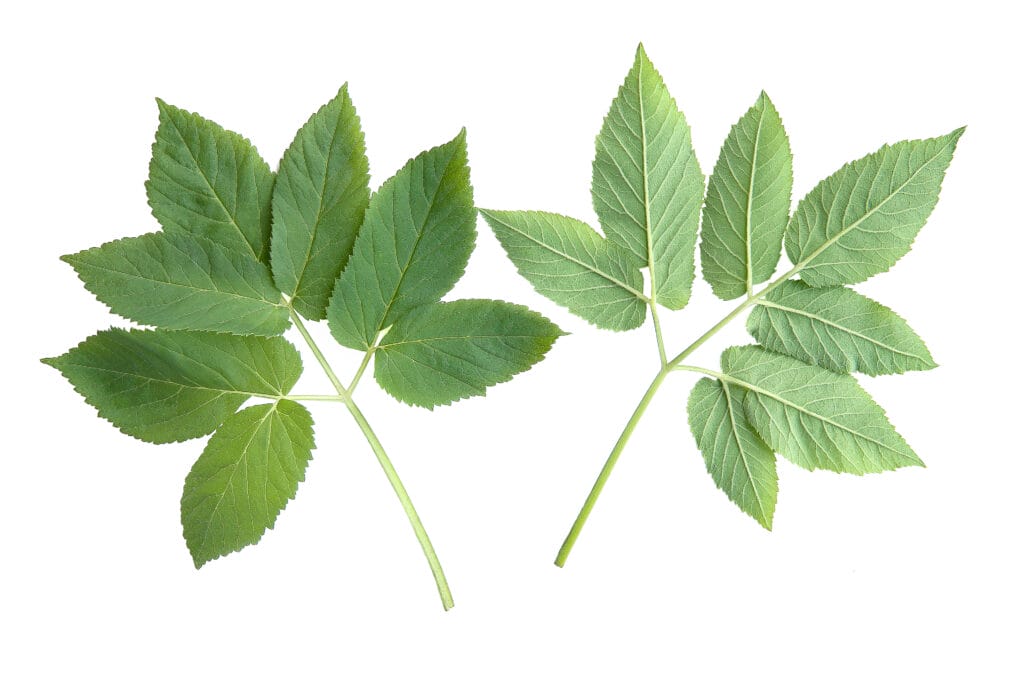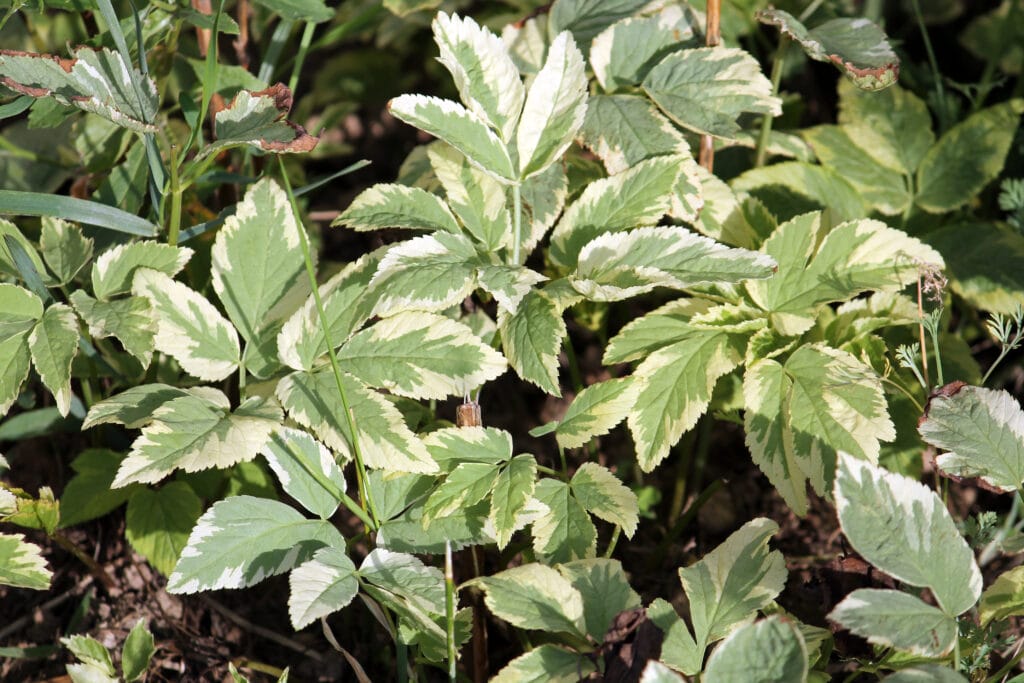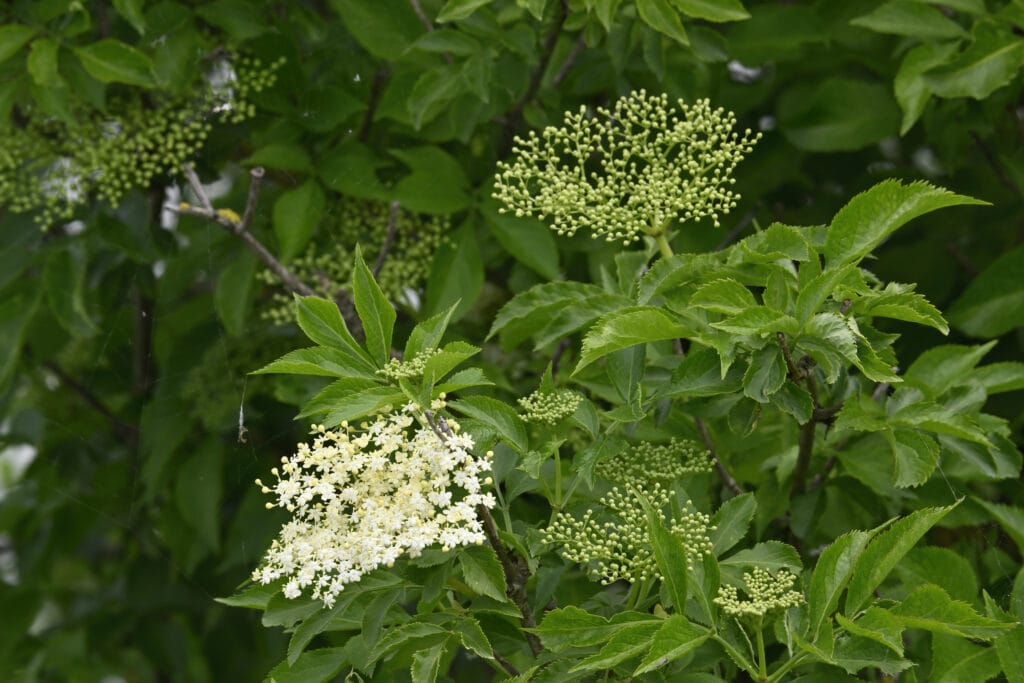Ground elder, scientifically known as Aegopodium podagraria, is a perennial umbellifer that is part of the same family (Apiaceae) as carrot. It was first introduced to Britain by the Romans, and its attractive characteristics and white flowers have often led to the plant being used in gardens for ornamental purposes. Ground elder, often also referred to as Herb Gerrard, Bishops Weed or Goutweed, forms excellent ground cover. So good in fact, it’s common for other plants to be blocked out, leading to ground elder removal services being sought. When established in the ‘wrong’ location, the ground elder plant can ruin a carefully planned garden scheme. The culinary and medicinal interest in the plant’s leaves makes ground elder identification all the more important, particularly as some lookalikes are poisonous.
What does Ground elder look like?
The ground elder plant is low growing, with the main leaf canopy normally growing to a height around 50 cm tall. However, the flowering stems will grow taller, sometimes reaching a metre. As ground elder spreads, the stem and leaf clusters appear like a green mat across the ground.

Aegopodium podagraria commonly called ground elder, herb gerard, bishop’s weed, goutweed, gout wort iStock/vaitekune
Common Ground elder (Aegopodium podagraria)
The leaves of ground elder are smooth and hairless, their oval shape sometimes obscured by the teeth along their edges and mostly arranged in groups of three from the end of the thin stems. New common ground elder leaves are light green, then as the season progresses they go darker in colour. The upper leaf is normally split, so it looks like three leaves, while each of the lower leaves appear to split into an asymmetrical pair. The stem provides another identifier, having a distinctive triangular cross section and a deep groove running along one side. Ground elder flowers are, individually, very small, but they appear in clusters or umbels of many flowers around May and June, and will be a bright white when mature.
Common ground elder is very good at exploiting disturbed ground, and can often be found along roadsides and footpaths, as well as woodland margins and clearings, along hedgerows, in churchyards and, of course gardens.
Variegated ground elder (Aegopodium podagraria ‘Variegatum’)
Variegated ground elder (Aegopodium podagraria ‘Variegatum’) is a cultivated variety of the common ground elder, which can be distinguished as follows:
Foliage Colour: The most notable difference is the foliage colour. While the common ground elder has solid green leaves, the variegated variety has leaves that are edged or mottled with cream or white. This variegation makes it a more ornamental choice, often preferred for its decorative appearance in gardens.
Growth Rate: Variegated ground elder tends to grow more slowly than its common counterpart. This can be beneficial in a garden setting, as the common ground elder is known for its aggressive growth and can quickly become invasive.
Vigour: Generally, the variegated form is considered less vigorous and less invasive than the common ground elder. However, it can still spread quite readily and should be planted with this consideration.
Uses: Whilst both varieties share similar historical medicinal uses, common ground elder that is more traditionally recognised for these purposes. The variegated form is primarily used for ornamental purposes due to its attractive foliage.
Despite these differences, variegated ground elder retains many of the characteristics of the common ground elder. These include its overall shape, flower form, and growth habits. As with any plant, especially those that can be invasive, consider your local environment before planting.

Foliage of Goutweed variegata or Aegopodium podagraria. Ornamental form with variegated leaves iStock/kazakovmaksim
Ground elder look-alikes
The term ‘elder’ in its name is believed to derive from a resemblance its leaves have to those of the elder tree (Sambucus nigra). Despite this visual similarity, both leaves and flowers look like ground elder, they are not botanically related. Elder trees have been significant in various cultures for their medicinal and mythical properties, and so the ground elder might have been named to reflect a perceived, albeit superficial, connection.
At this point it’s worth noting that ground elder is a member of the Apiaceae family. These plants are often known as umbellifers, and their flower umbels can look incredibly similar. While many edibles such as carrot, fennel, celery and parsley lie in this group, other member plants are incredibly harmful. Harmful ground elder look alikes such as the phototoxic giant hogweed and the deadly poisonous hemlock water dropwort. Other notable ground elder lookalikes:
Bishop’s weed (Pimpinella major): Also known as greater burnet saxifrage, this plant has similar-looking leaves to ground elder. However, it’s generally taller, and its leaves are more deeply cut.
Cow Parsley (Anthriscus sylvestris): Often found in similar habitats, cow parsley has somewhat similar, albeit more finely divided, fern-like leaves. It’s a common plant along hedgerows and in meadows.
Japanese Anemone (Anemone x hybrida): In its early growth stages, the leaves of Japanese anemone can be mistaken for ground elder due to their similar shape and texture.

Elderberry (Sambucus nigra) in bloom displaying characteristics similar to ground elder iStock/mauribo
Is ground elder edible?
It’s believed that the Romans introduced ground elder to Britain for its culinary versatility and medicinal benefits. The young leaves can be eaten raw, offering a slightly bitter, herbaceous flavour similar to a blend of celery, aniseed and parsley. Ground elder leaves are full of nutrients, and can be added to salads, omelettes, soups and stocks, as well as going well with meat and fish when used like a herb such as parsley.
Best harvested in spring when the leaves are at their most tender and palatable. After ground elder flowers, the leaves can develop an unpleasant taste (and it’s said that eating the older leaves can have a laxative effect). Of course, if you go foraging for ground elder, make absolutely sure that you know precisely what it is that you’re looking for and, if not, don’t eat it. There are ground elder lookalikes that are toxic.
Medicinal uses
Ground elder (Aegopodium podagraria) has a history of medicinal use dating back to ancient times, although it’s less commonly used in modern herbal medicine. Here are some of its traditional medicinal uses:
Gout and Arthritis: Perhaps the most well-known traditional use of ground elder leaves in the treatment of gout and arthritis. Its specific epithet, “podagraria,” refers to podagra, a term for gout affecting the foot. It was believed to help reduce pain and inflammation associated with these conditions.
Diuretic Properties: Ground elder has been used as a diuretic to help increase urine production, potentially aiding in flushing out toxins and reducing fluid retention.
Digestive Aid: Some traditions have used ground elder to help with digestion, soothing stomach aches, and improving overall digestive health.
Wound Healing: Externally, ground elder has been used in poultices for wound healing due to its purported anti-inflammatory properties.
Vitamin and Mineral Source: As an edible plant, ground elder has been a source of vitamins and minerals, particularly in the early spring when other food sources might have been scarce.
While these uses are part of traditional knowledge, it’s important to note that the efficacy and safety of ground elder as a medicinal herb are not well-established by modern scientific standards. Much of the knowledge about its medicinal uses comes from historical or anecdotal sources rather than rigorous scientific research.
If you’re considering using ground elder or any other herbal remedy for medicinal purposes, it’s crucial to consult with a healthcare professional first. Additionally, ensure that any plant you use for medicinal purposes is correctly identified and sourced from a safe, unpolluted area.
Is ground elder poisonous?
Ground elder is not considered a poisonous plant, although you may want to be selective as to when (and if) you eat it. As the yearly growth matures and goes into flower, the leaves and stems of the ground elder develop a darker green colour. Along with the colour change, the taste of the leaves starts to turn into something less palatable. It’s also said that older ground elder leaves will have a laxative and soporific effect on those who consume enough.
Ground elder is an umbellifer of the Apiaceae family, a huge group of flowering plants, often known as the carrot, celery or parsley family. Many in this group are harmless or even edible. However, a significant number are toxic or highly poisonous, they include Giant Hogweed and Poison hemlock. Whilst ground elder has a distinctive stem cross-section that helps distinguish ground elder leaves, the flower-head shape is very similar to many other umbellifers.
N.B. Misidentification is a common risk when foraging for wild plants. Ground elder can be confused with other plants that are not edible or are toxic. It’s crucial to be 100% certain of the plant’s identity before consuming it.
How invasive is ground elder?
Whilst ground elder is certainly invasive in the sense that it spreads quickly and can dominate areas to the exclusion of other plants, it has been naturalised to the UK, and is native to mainland Europe. Aggressive growth and ability to spread quickly via its rhizome system make ground elder a nuisance for gardeners and land managers. Common ground elder often thrives where human activities disturb the ground, and once established it can be difficult to eradicate. Ground elder’s behaviour in gardens, and disturbed areas, can mimic that of non-native invasive species. Consequently, the methods used in management strategies to control and eradicate ground elder follow the same principles used for these plants.
If you are concerned about common ground elder, lookalikes or any invasive native or non-invasive plants, call 0203 174 2187 or 01202 816134 to talk to one of our consultants today.
Lead image iStock/LordRunar

